
1950-1955 NYC: Unveiling a New Era of Cultural Brilliance and Architectural Genius
Between 1950 and 1955, New York City experienced an unparalleled period of cultural and economic growth. The early ‘50s saw the city solidifying its position as a global cultural hub, with the expansion of the arts, literature, and music scenes. Jazz clubs in Harlem and Greenwich Village pulsed with the innovations of bebop, while Broadway theaters premiered groundbreaking works that would become classics. This era also witnessed the establishment of influential art movements, particularly Abstract Expressionism, further asserting NYC’s pivotal role in the global art community.
The city’s architectural landscape underwent significant transformations, reflecting the economic prosperity of the post-war era. Iconic structures, such as the United Nations Headquarters completed in 1952, symbolized New York’s growing influence in international affairs. Meanwhile, residential skyscrapers began to reshape the skyline, offering modern living spaces that catered to an increasing population. These developments underscored a period of architectural innovation and urban planning that sought to accommodate New York’s rapid growth.
During this time, New York’s economy thrived, buoyed by advancements in manufacturing, commerce, and the burgeoning field of television broadcasting. The city became a magnet for aspiring actors, writers, and artists, drawn by the flourishing entertainment industry and the promise of the American Dream. This influx of talent contributed to the vibrant cultural tapestry that defined the city, making it a beacon for creativity and innovation.
By 1955, New York City had not only embraced its identity as a melting pot of cultures but also as a leader in defining the post-war American zeitgeist. The achievements in arts, architecture, and economic development during these years laid the foundation for the modern metropolis, shaping its trajectory for decades to come. This dynamic period in NYC’s history remains a testament to its resilience, creativity, and unwavering spirit of progress.
Timeline of New York City’s History 1950-1955
Discover surprising historical facts about The City That Never Sleeps—explore fun, educational insights into its history, population, iconic landmarks, and more, perfect for students, history enthusiasts, and anyone curious about NYC’s rich heritage.
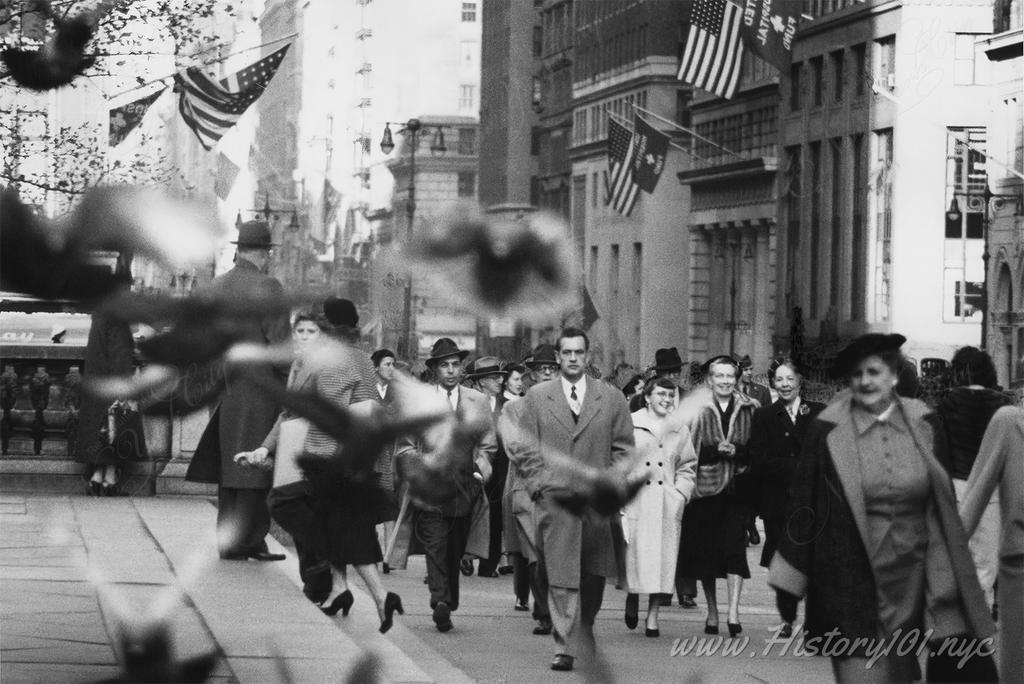
1953: Pedestrians at the New York Public Library
Photograph of pedestrians scattering a flock of pigeons along the sidewalk in front of New York Public Library.
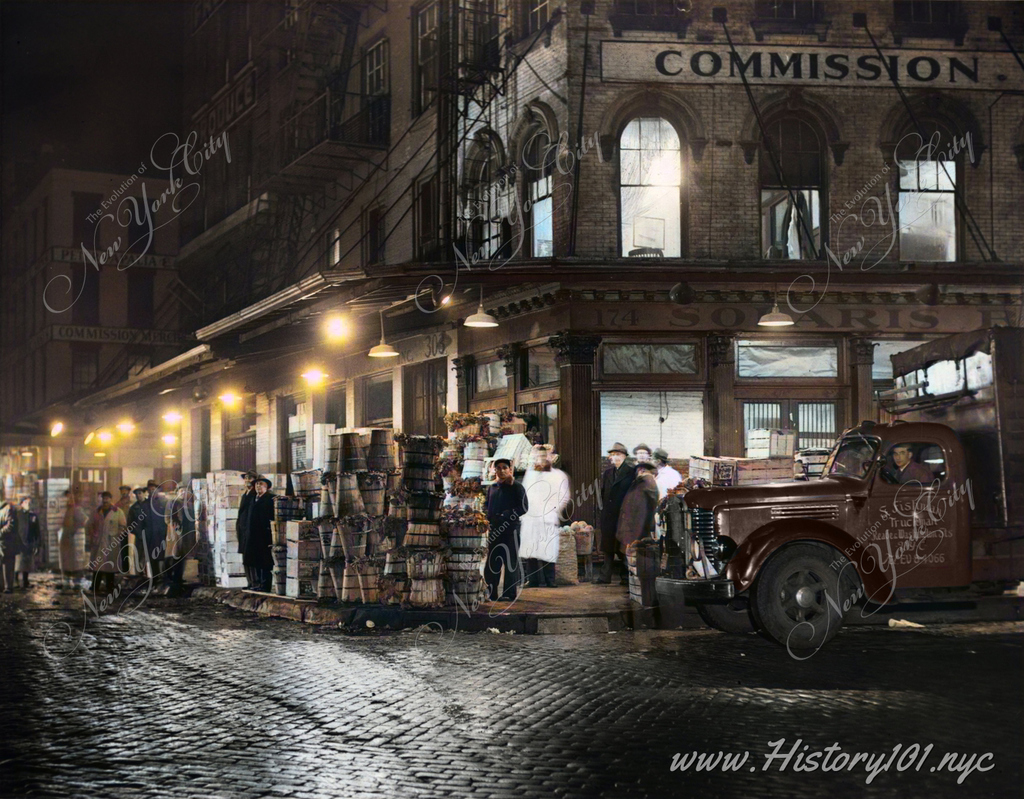
1952: Walter Albertin Photo: Washington Street Market at Night in NYC
1952 NYC Night Market Photo by Walter Albertin
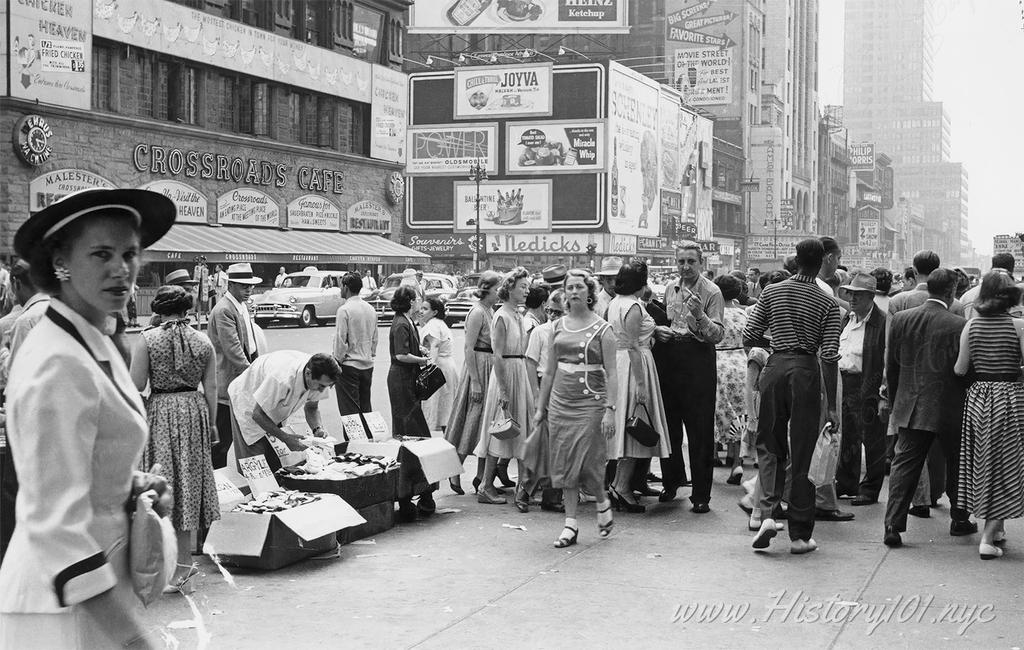
1953: Times Square Showing Advertisements
Photograph of Times Square showing advertisements and businesses such as the Crossroad's Cafe and Nedicks.
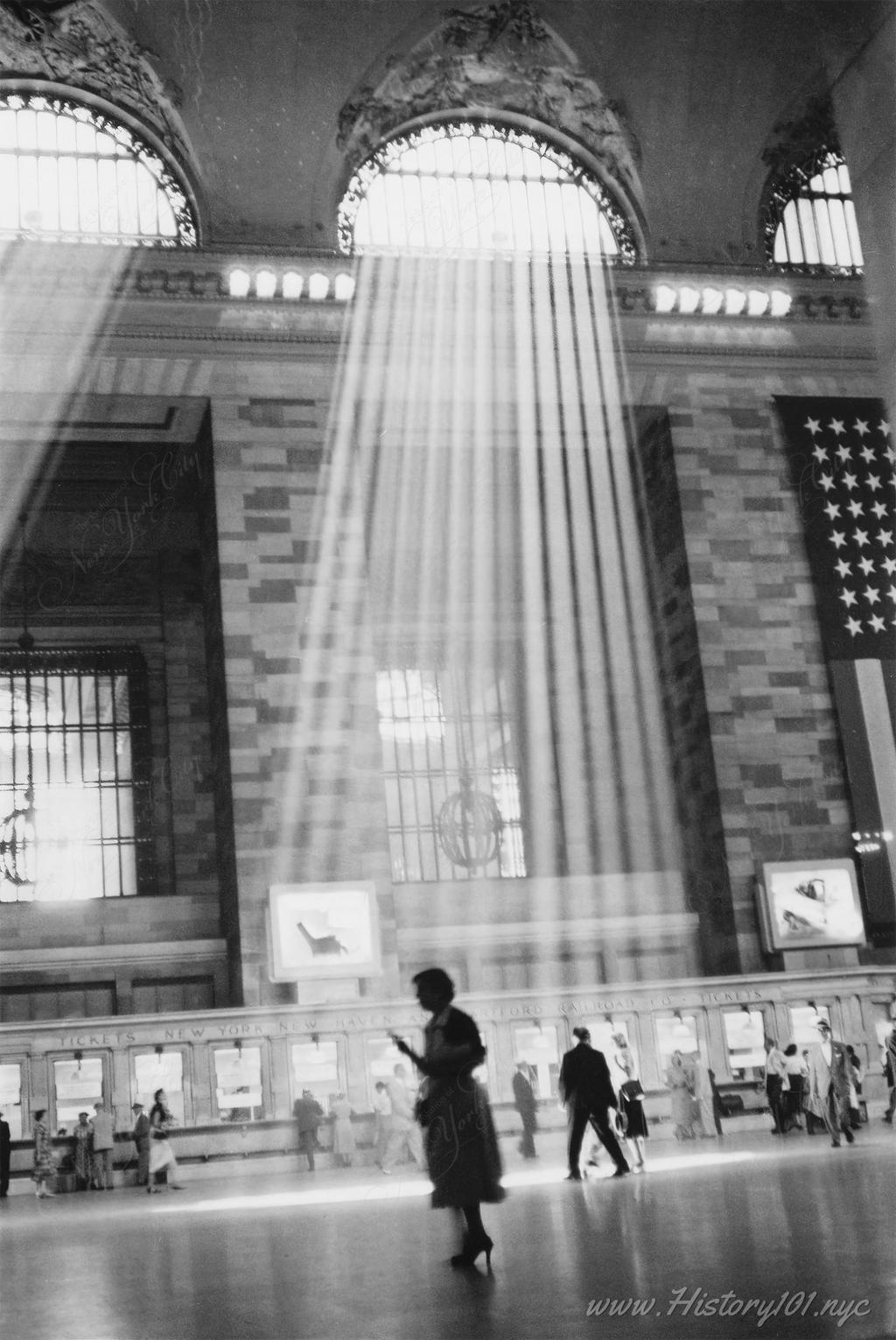
1953: Grand Central Sculpture of Light
Photograph shows the interior of main concourse of Grand Central Terminal with sunlight streaming through windows of main concourse.

1952: Aerial view of Midtown Manhattan
Aerial photograph of Manhattan including the Chrysler Building and other midtown skyscrapers.
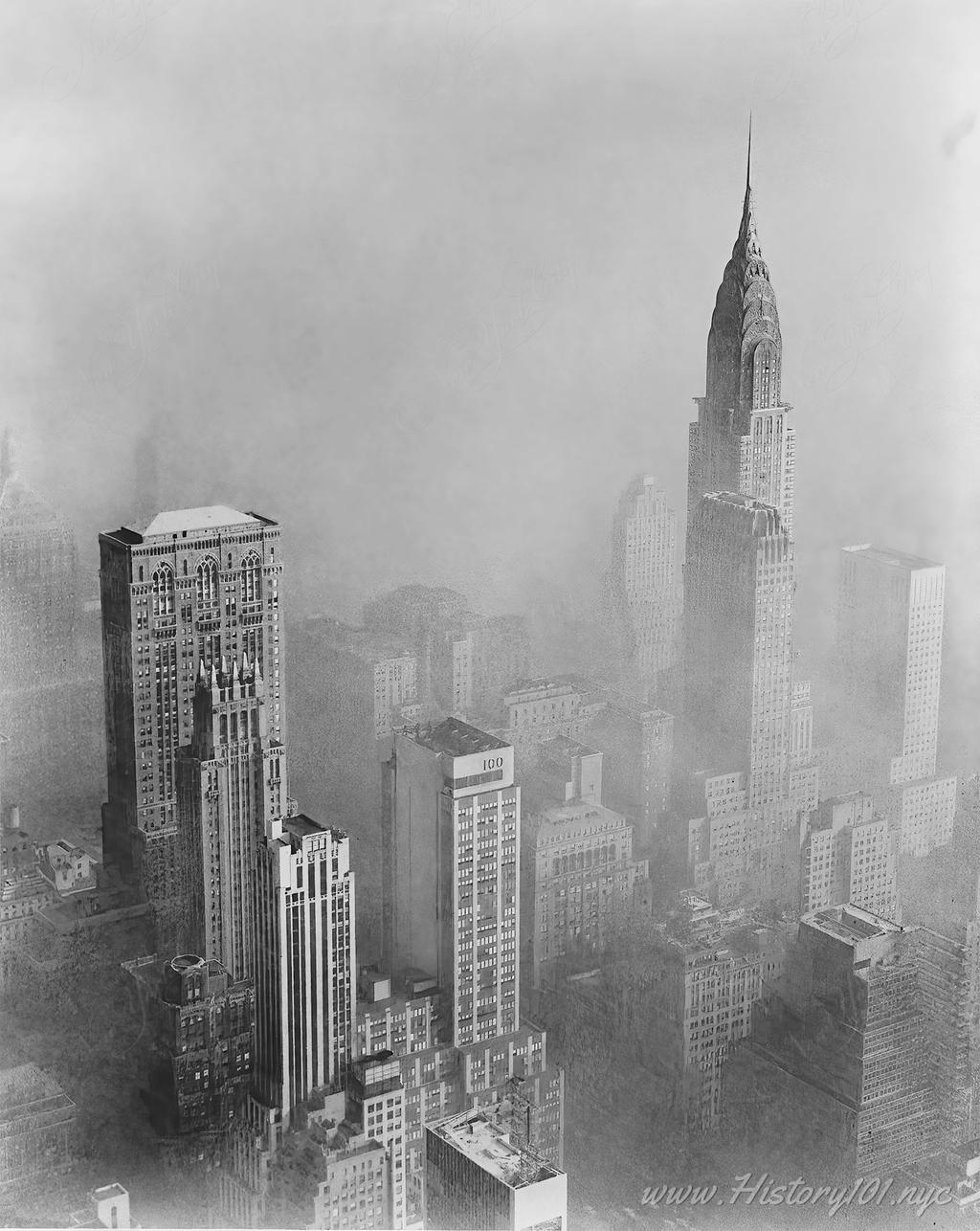
1953: Midtown Smog Obscures View of Chrysler Building
Aerial photograph of smog obscuring a view of the Chrysler Building from the Empire State Building.
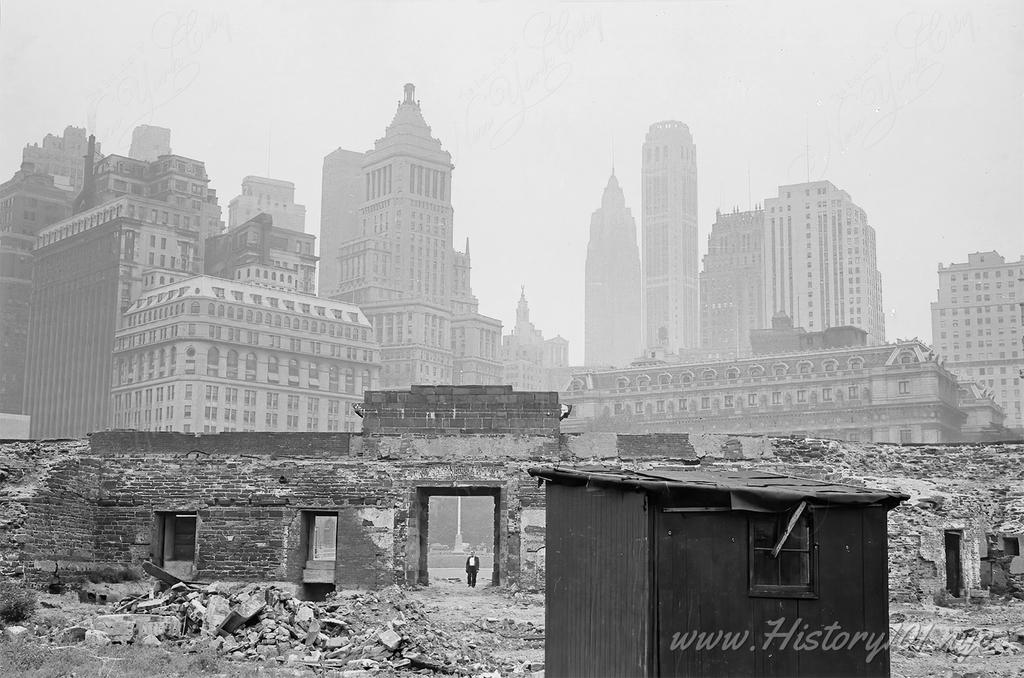
1952: Man Standing in Building Ruins
Photograph of a man standing in the doorway of a building in ruins against a backdrop of skyscrapers.
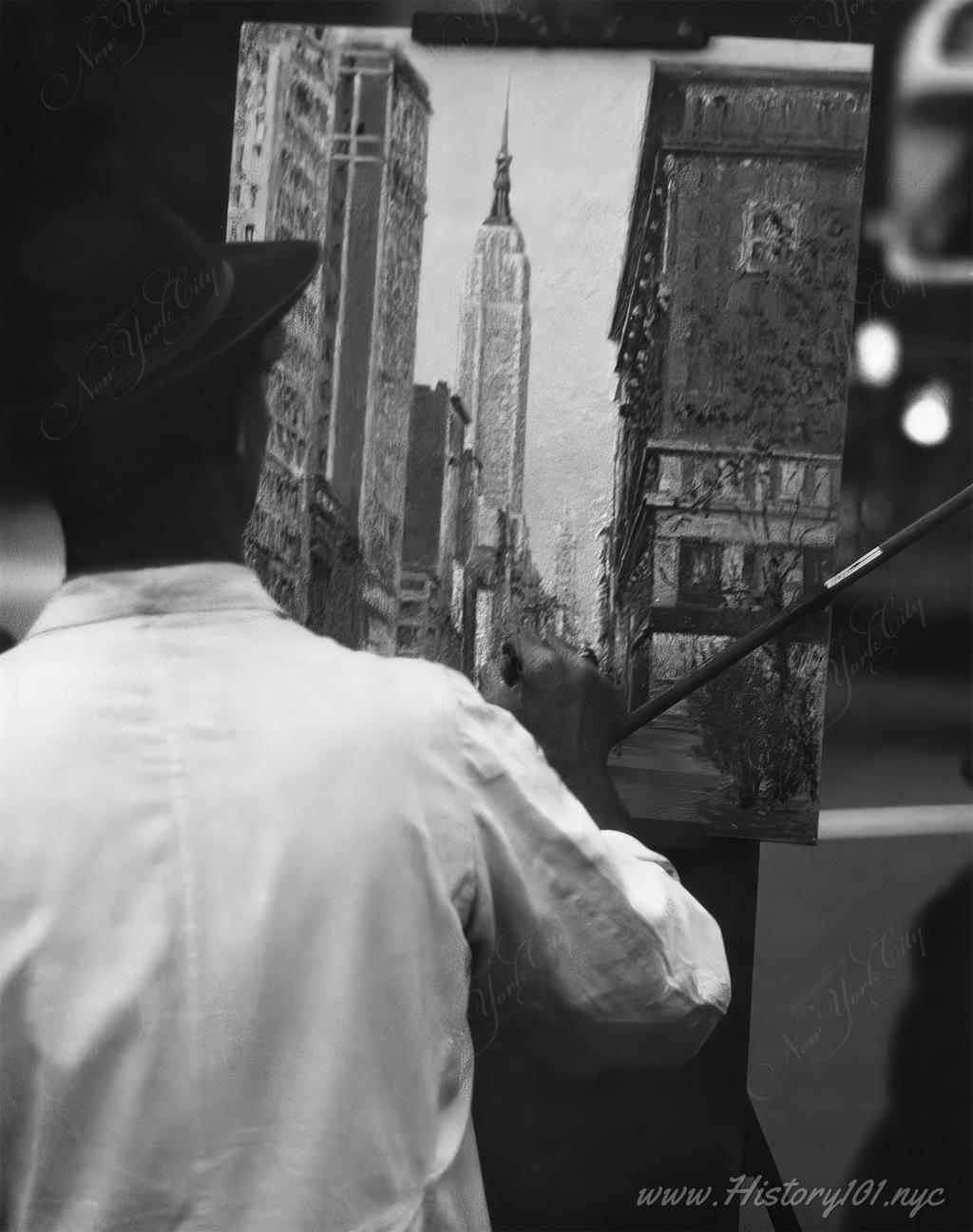
1953: Street Artist Painting a Cityscape
Photograph shows half-length portrait of an street artist working on a painting of Manhattan's urban landscape with the Empire State Building in the background.

1952: Aerial View of Downtown Manhattan
Photograph shows an aerial view of Manhattan including the East River featuring the Manhattan and Brooklyn bridges.
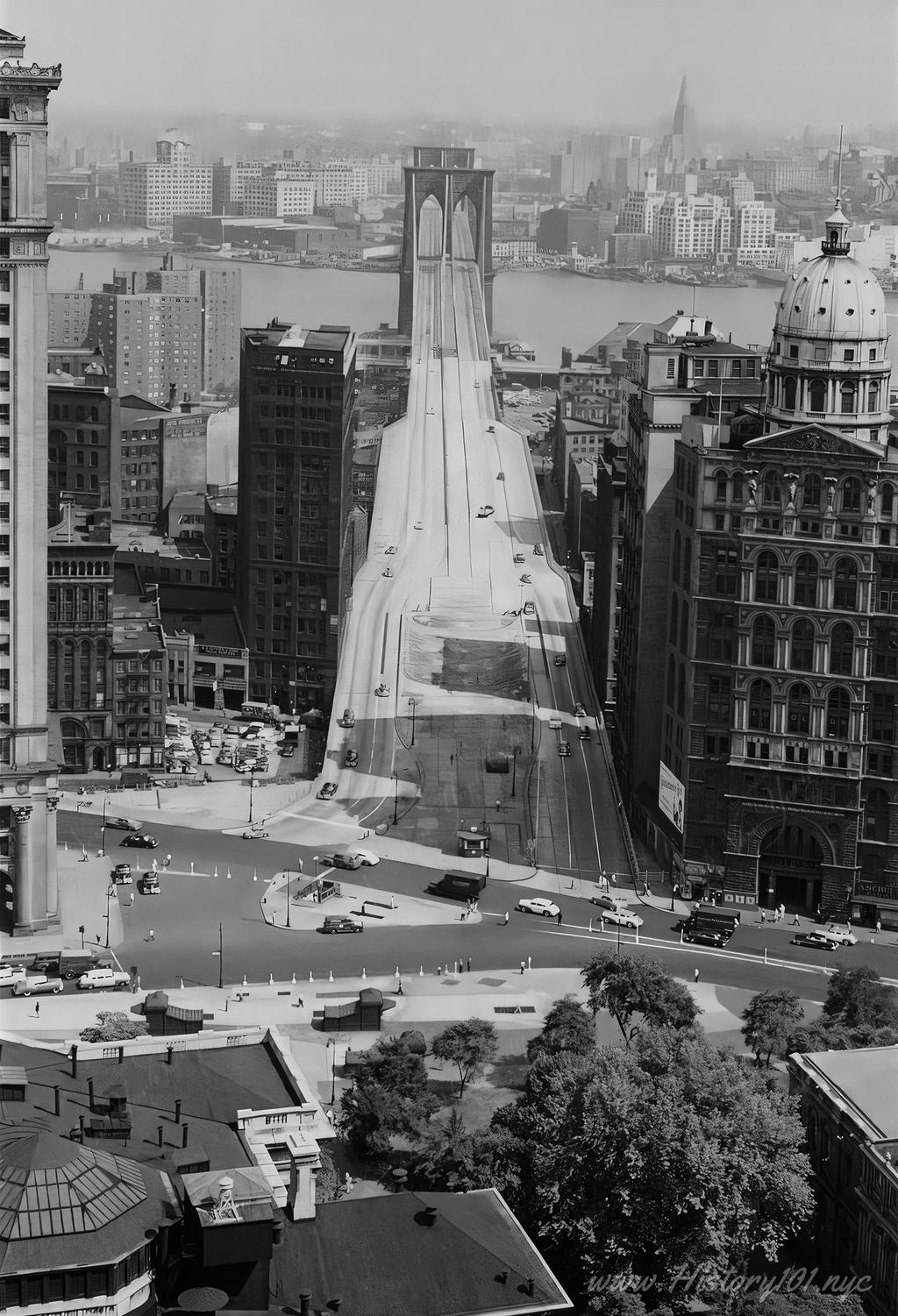
1954: A View across the Brooklyn Bridge
Aerial photograph looking across the East River towards Brooklyn from Manhattan's perspective.
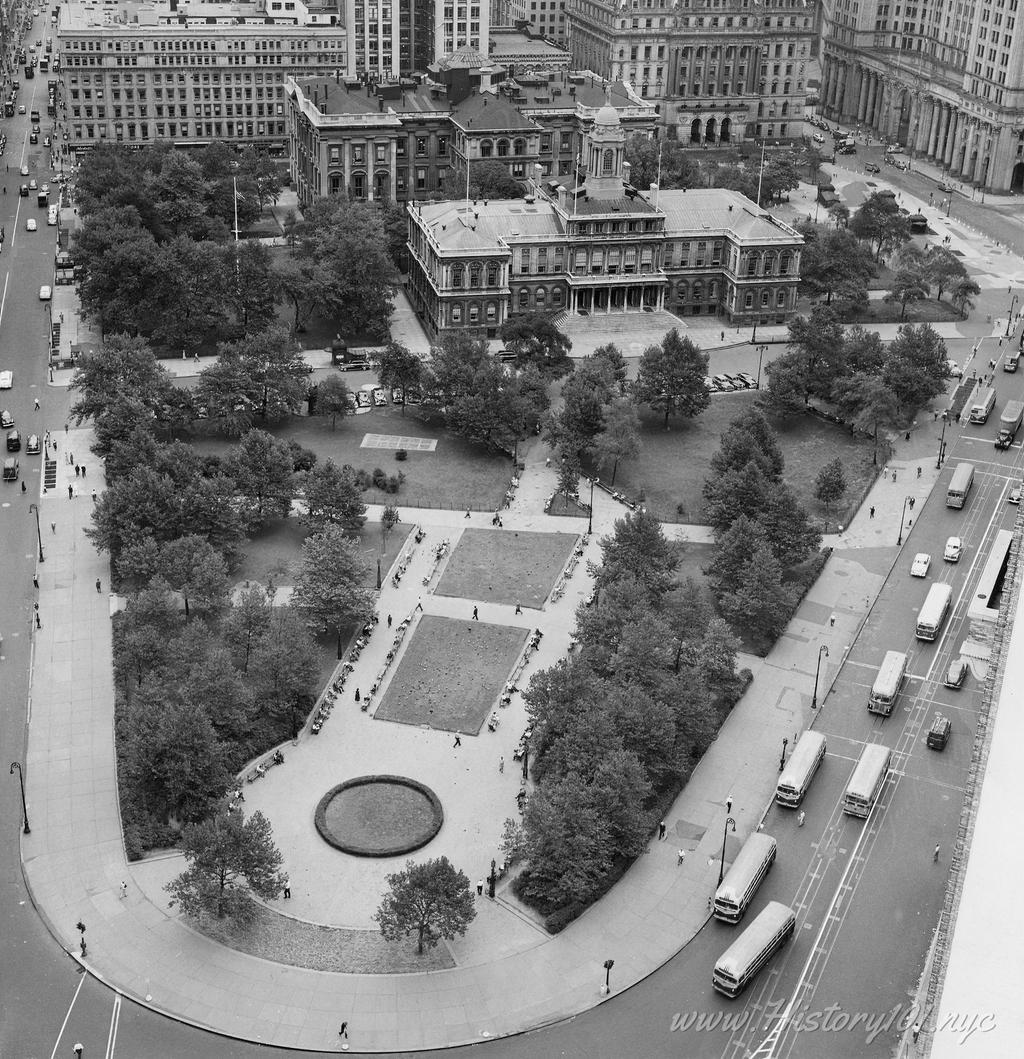
1952: Aerial View of City Hall Park
Photograph shows view of Broadway looking south from above the 135 highway with large skyscraper in distance and subway tracks emerging from the ground.
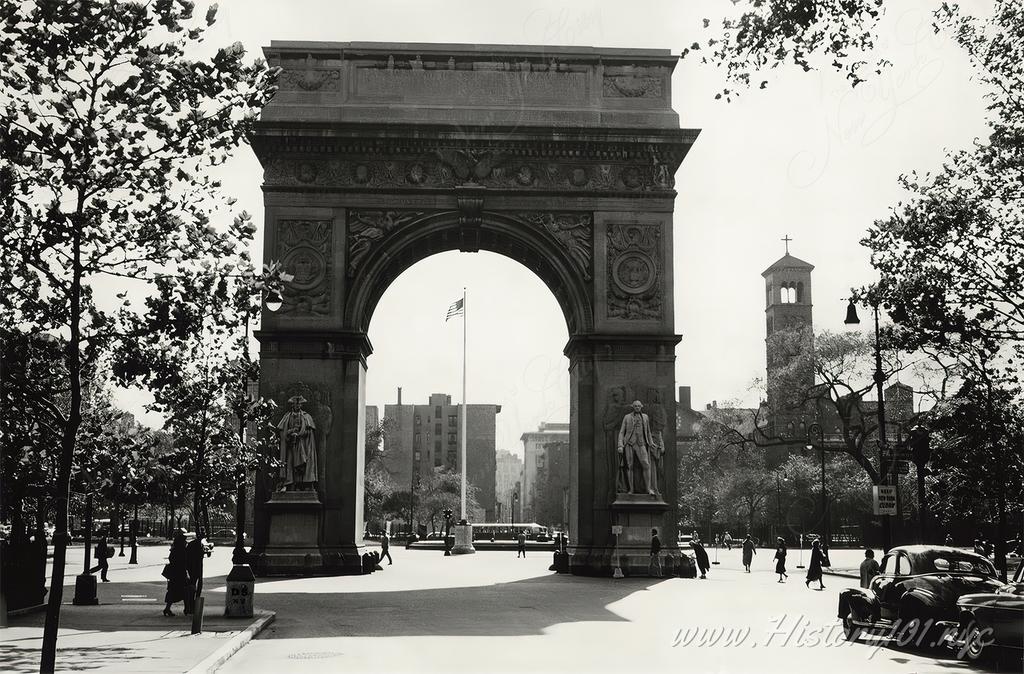
1953: Washington Square Arch
Photograph of the Washington Square Arch located at Washington Square Park in Greenwich Village, with its iconic fountain in background, visible through arch.
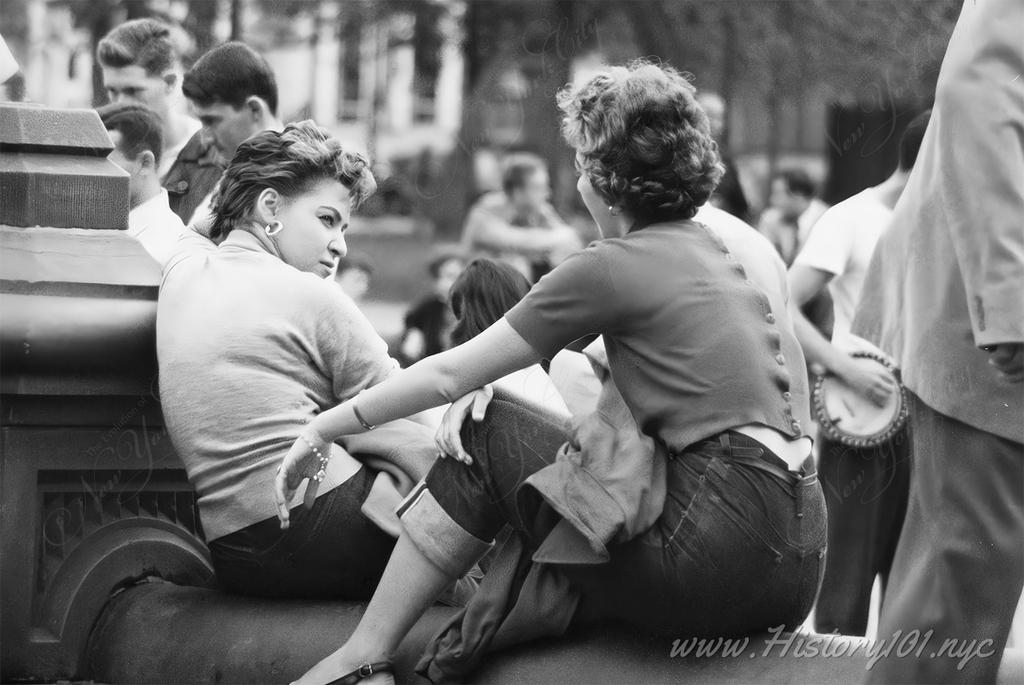
1953: The Fountain Steps of Washington Square Park
Photograph of two women sitting on the Fountain steps of Washington Square Park in Greenwich Village.

1953: Two Women Talking on City Street
Photograph shows two separate shots of women having a conversation on the curb in front of a New York City taxi.

1954: Times Square Traffic
Photograph looking north at traffic along 7th Avenue facing Times Square with its many billboards and storefronts.
Timeline of New York City: 1950-1955
1950: The United States Census revealed New York City's total population to be 7,891,957, marking it as the most populous city in the nation at that time. This total included a detailed breakdown by borough, showcasing the Bronx with 1,451,277 residents, Brooklyn with the highest count at 2,738,175, Manhattan with 1,960,101, Queens with 1,550,849, and Staten Island with 191,555. These figures highlight the city’s dense and diverse demographic spread, pivotal for understanding its socioeconomic dynamics during the post-World War II era.
The census data is crucial for appreciating New York City's historical and cultural evolution. This period was characterized by significant urban development and transformation, influenced heavily by the robust population growth in each borough. The demographic details from the census underline the city's role as a melting pot of cultures and an epicenter of economic activity. This snapshot from late 1950 provides a foundation for analyzing trends in migration, housing, and the expansion of public services, which have continued to shape the city's trajectory as a global metropolitan leader.
1950: Vincent R. Impellitteri was elected the 101st mayor of New York City in a special election held in November, following the resignation of William O'Dwyer, who was appointed as the U.S. Ambassador to Mexico. Impellitteri's ascent to the mayoralty marked a significant moment in the city's political landscape, taking office during a period of economic recovery post-World War II. His administration dealt with the challenges of urban growth, managing the complexities of a bustling metropolis that was undergoing significant demographic and infrastructural changes.
The role of mayor since the consolidation of Greater New York in 1898 has been pivotal in shaping the city's administrative policies and responses to its expanding needs. Impellitteri's tenure added to this rich tapestry of governance, reflecting New York City's dynamic leadership in adapting to changing times. His election in November 1950 underscores New York's historical trajectory as a center of political activity and urban development, continuing its legacy of influential leadership.
1950: New York City witnessed the launch of the first multipurpose charge card, known today as the credit card, introduced by Diner’s Club. This innovation provided a novel method of payment at a local restaurant and stemmed from an incident in 1949 when businessman Frank McNamara forgot his wallet while dining out. To avoid future embarrassments, McNamara, with partner Ralph Schneider, used a small cardboard Diners Club Card in February 1950 at Major's Cabin Grill, marking the beginning of the multipurpose charge card era. This pivotal event, dubbed the "First Supper," transformed how both consumers and businesses manage transactions.
Within its first year, the Diners Club Card gained 10,000 members, mainly New York's business elite, and was accepted at 28 restaurants and two hotels. Its influence quickly expanded, introducing travel insurance in the 1950s and transitioning from cardboard to plastic in the 1960s, even appearing with Audrey Hepburn in "Breakfast at Tiffany's." The subsequent decades saw further innovations, such as the launch of corporate cards in the 1970s and Club Rewards® in the 1980s. The legacy continued when BMO Financial Group acquired the Diners Club North American franchise on December 31, 2009, reinforcing the ongoing tradition of financial innovation rooted in New York City.
1950: The Kootz Gallery at 15 E. 57th Street in New York City hosted a pivotal group show from April to May titled "Talent 1950," curated in part by the influential art critic Clement Greenberg. This exhibition marked a significant moment in the art world, featuring emerging talents who would go on to define a new direction in modern art. Among the artists showcased were Franz Kline and Elaine de Kooning, the latter being the wife of the renowned painter Willem de Kooning. The show played a crucial role in introducing these artists to a broader audience and cementing their positions in the art community.
The exhibition contributed significantly to New York City’s historical and cultural narrative as a center of artistic innovation and discovery. Organized during a time when the city was increasingly becoming the epicenter of the global art scene, this event helped establish New York as a vital locale for modern art, influencing countless artists and movements in the decades that followed. The exhibition not only elevated the careers of its featured artists but also highlighted New York’s unique role in shaping the trajectory of contemporary art well into the late 20th century.
1950: The Korean War, a significant conflict in global history, commenced on June 25, when North Korean forces invaded South Korea, pushing international tensions to a climax during the Cold War era. This conflict drew military personnel from across the United States, including numerous service members from New York City, who were deployed to various battlefronts across Korea. The city's participation is a testament to its deep-rooted connection to national events and its significant contributions to major international endeavors.
The war concluded on July 27, 1953, with the signing of an armistice, bringing an end to the hostilities but leaving a lasting impact on veterans and their communities back home, particularly in New York. The return of these service members to New York City brought about changes in the local dynamics, as they reintegrated into civilian life and contributed to the city’s cultural and social fabric. This period in history highlights New York City's resilience and its crucial role on the national stage, adapting to post-war realities and influencing the broader narrative of the United States during the mid-20th century.
1950: On November 22,, one of the deadliest train disasters in the history of New York City occurred at the Kew Gardens station in Queens. The collision involved two Long Island Rail Road trains, leading to 78 fatalities and 363 injuries. This tragic event brought immediate attention to the safety standards of the city's rail system and highlighted the critical need for rigorous safety protocols and infrastructure improvements.
The impact of the Kew Gardens train crash resonated beyond the immediate tragedy, prompting a reevaluation of public transportation safety measures not only in New York City but across the nation. As a result of this catastrophic incident, which unfolded in late November 1950, significant advancements were made in the implementation of safety technologies and operational practices. These changes helped to prevent future incidents, reflecting New York City's role in pioneering urban transportation safety and management, which has continued to influence national standards and practices.
1950: The Museum of Modern Art (MoMA) in New York City made a significant addition to its collection by acquiring Jackson Pollock's "Number 1A, 1948." This artwork is renowned for its pioneering role in the Abstract Expressionist movement, showcasing Pollock's innovative drip technique that would come to define an era of modern art. The acquisition highlighted MoMA's commitment to embracing and promoting cutting-edge art, reinforcing its status as a leading institution in the global art community.
The presence of "Number 1A, 1948" in MoMA's collection has not only enriched the cultural assets of New York City but also attracted art enthusiasts and scholars from around the world, enhancing the city’s appeal as a major cultural center. The acquisition helped to cement New York City's reputation as a hub for artistic innovation and an essential destination for experiencing the evolution of contemporary art. This strategic addition to MoMA's collection demonstrates the city’s ongoing influence in shaping global art trends and dialogues.
1950: On December 15, New York City marked a significant milestone in its transportation history with the opening of the Port Authority Bus Terminal. Located in the heart of Manhattan, this facility quickly became one of the largest and busiest bus terminals in the world. It was designed to centralize the city's bus services, streamlining commuter traffic and long-distance travel, which were previously dispersed across numerous smaller sites. The establishment of this terminal was a critical step in organizing and facilitating the mass transit needs of the metropolitan area.
The Port Authority Bus Terminal's inauguration played a crucial role in enhancing New York City's urban infrastructure. By consolidating bus traffic, the terminal helped reduce congestion on city streets, thereby improving overall traffic flow and accessibility. This development not only boosted the city’s economic vitality by making it more accessible to commuters and tourists but also set a standard for urban transportation planning. The terminal's operation has had lasting impacts on the city's growth and functionality, reinforcing New York’s status as a global center of commerce and movement.
1951: During the early post-World War II period, the Texas Eastern Transmission Corporation undertook a significant project to repurpose wartime pipelines for peacetime use, transforming the Big Inch and Little Big Inch pipelines originally used for transporting oil into conduits for natural gas. This repurposing initiative was crucial in establishing a robust infrastructure for natural gas delivery from Texas to the northeastern United States, including New York City. These pipelines had been critical during the war for safely transporting fuels away from areas vulnerable to enemy attacks and were now adapted to meet the growing energy demands of the post-war economy.
The availability of natural gas via these pipelines, completed during the war and transitioned to natural gas service shortly thereafter, was instrumental in fueling New York City's economic growth and industrial expansion. By providing a reliable energy source, the pipelines supported various industries and residential needs, enhancing the city’s quality of life and contributing to its mid-20th-century modernization efforts. This development not only ensured energy security for New York City but also bolstered its status as a leading urban center, prepared to meet the challenges of a rapidly modernizing world.
1951: New York City witnessed a landmark legal decision that significantly impacted its housing policies. The New York State Court of Appeals made a pivotal ruling against racial segregation in Stuyvesant Town, a privately owned development that had received city assistance through public funding. This case, known for challenging the discriminatory practices of its owners, set a crucial legal precedent by emphasizing that public funding should align with non-discriminatory principles, marking a significant stride towards racial equality in housing.
The outcome of the Stuyvesant Town case not only impacted New York City's approach to city-assisted housing projects but also echoed across the nation, influencing civil rights legislation and housing policies. This decision reinforced New York City’s leadership in advocating for progressive social reforms and set the stage for future civil rights advancements. The ruling highlighted the city's ongoing commitment to addressing and rectifying racial inequalities, thereby fostering a more inclusive urban community. This shift towards equitable housing practices reflected broader societal changes and helped shape the city's social and legal landscape through the mid-20th century.
1951: New York State enacted its own set of rent control laws, transitioning from the World War II-era federal laws established under the Emergency Price Control Act of 1942. This change was prompted by the expiry of federal controls, which were initially introduced to manage housing costs and prevent rent hikes during the economic upheaval of the war. The new state legislation aimed to address the ongoing housing shortage and the need for stable rental prices in the post-war era, affecting over two million rental units across the state.
This legislative shift allowed New York to customize rent control policies to better meet the specific demands and challenges faced by its diverse population. For New York City, in particular, these rent regulations have been crucial in preserving affordable housing options for countless residents, thereby supporting the city's economic diversity and promoting neighborhood stability. By managing rent control at the state level, New York underscored its commitment to protecting tenants and ensuring a balanced urban development, reflecting its proactive approach to urban management and social welfare.
1951: New York City hosted "The 9th Street Show," a seminal art exhibition that played a crucial role in the development and recognition of the Abstract Expressionist movement. Organized by Leo Castelli and held at 60 East 9th Street, this event showcased the works of some of the most pivotal figures in American art, including Jackson Pollock, Willem de Kooning, Mark Rothko, Hans Hofmann, Clyfford Still, and Barnett Newman. The exhibition was instrumental in highlighting the diverse and dynamic approaches within the movement, bringing these artists into the public eye and solidifying their contributions to modern art.
The impact of "The 9th Street Show," extended beyond the exhibition itself, reinforcing New York City’s status as a vibrant center for artistic innovation. By featuring such a powerful lineup of artists, the show not only cemented the reputations of its participants but also underscored the city's role in shaping the direction of contemporary art globally. This exhibition was pivotal in positioning New York at the forefront of the international art scene, fostering a cultural environment that would continue to influence and define global artistic trends for decades to come.
1951: On April 20, New York City hosted a grand ticker-tape parade in honor of General Douglas MacArthur following his controversial removal from command by President Harry S. Truman. This parade, one of the most massive in the city's history, drew millions of spectators who lined the streets to view the procession. The event was marked by a significant outpouring of public support for MacArthur, reflecting the general's popularity and the contentious nature of his dismissal during the ongoing Korean War.
This spectacular ticker-tape parade not only celebrated General MacArthur's military career but also demonstrated New York City's pivotal role as a venue for significant national events. The parade contributed to the city's reputation as a center for major public gatherings and celebrations, reinforcing its cultural and historical significance. By hosting such a high-profile event, which took place in April, New York City continued to strengthen its identity as a stage for expressing national sentiments and for commemorating figures and moments that shape American history.
1951: On June 11, The New York Times reported that the New York City subway system would begin to auction off unclaimed items left behind by passengers. This announcement marked an official acknowledgment of a unique aspect of city management, addressing the handling of lost property in one of the world’s busiest transit systems. The practice of auctioning items not only cleared space in the lost and found facilities but also recouped some financial return for the transit authority, showcasing an efficient approach to dealing with lost items that were not reclaimed within a designated period.
These auctions, initiated by the Metropolitan Transportation Authority (MTA), highlighted New York City's innovative and pragmatic methods in urban management. By engaging in such activities, the city demonstrated its ability to adapt and find solutions to everyday challenges within its massive public transit system. Reporting such events, as The New York Times did in June, not only informed the public but also added to the city's rich tapestry of stories, illustrating the practical measures taken to manage the complexities of a vast and heavily utilized subway network. These efforts reflect New York City’s ongoing commitment to efficiency and public service in managing one of its most vital urban infrastructures.
1951: On June 25, New York City witnessed a groundbreaking moment in the history of broadcasting when CBS aired the first color television program. This event, a musical variety special titled "Premiere," was hosted by Arthur Godfrey from CBS's studio in New York City. The broadcast was transmitted to a network of five East Coast cities, marking a significant leap forward in television technology and expanding the medium's visual and aesthetic capabilities. This pioneering event showcased the potential of color television, initially reaching a limited audience due to the scarcity of color receivers at the time.
This historic broadcast significantly benefited New York City by reinforcing its status as a media and technology leader. The successful airing of "Premiere" placed the city at the forefront of technological advancements in television, highlighting its role as a hub for innovation and a trendsetter in the broadcasting industry. This event not only contributed to the evolution of media technology but also played a critical role in shaping the future of visual entertainment, enhancing New York City's influence and prestige in the global media landscape.
1951: On August 11, New York City marked a milestone in the history of sports broadcasting when WCBS televised the first baseball game in color. This historic broadcast featured a matchup between the Boston Braves and the Brooklyn Dodgers at Ebbets Field, where the Braves triumphed with a score of 8-1. The event showcased the technological advancements in television broadcasting and demonstrated the city's leadership in media innovation.
This pioneering broadcast not only enhanced the viewing experience for sports fans but also underscored New York City's significant role in the evolution of television technology. By hosting this first color broadcast of a baseball game in August 1951, New York continued to set trends in the broadcasting industry, expanding the possibilities for sports media coverage. This event contributed to the city’s legacy as a hub for technological innovation, further solidifying its influence on the national and global media landscapes.
1951: On October 3, a momentous event in Major League Baseball history unfolded at the Polo Grounds in New York City when Bobby Thomson of the New York Giants hit a walk-off home run against the Brooklyn Dodgers. This iconic home run, famously dubbed "The Shot Heard 'Round the World," clinched the National League pennant for the Giants in dramatic fashion. The game was the deciding third match of a three-game playoff series and remains one of the most celebrated moments in sports history, highlighting Thomson's pivotal role in baseball lore.
This event significantly enhanced New York City's historical and cultural tapestry, emphasizing its status as a central stage for unforgettable sports moments. The dramatic finish to the National League pennant race not only captivated local and national audiences but also showcased New York City's ongoing contribution to the vibrant narrative of American sports. By hosting such a landmark event in October, New York City reinforced its reputation as a hub for iconic sporting achievements, continuing to attract attention and admiration from around the world.
1951: On October 10, the New York Yankees clinched their third consecutive World Series title, defeating the New York Giants in six games. This victory not only marked their 14th title in franchise history but also underscored their dominance in Major League Baseball during the early 1950s. The series, featuring two iconic New York teams, was a highlight event in the city, drawing intense local and national interest. The performance of the Yankees throughout the series showcased their skill and strategic prowess, contributing to their enduring legacy as one of baseball's most successful teams.
The 1951 World Series had significant implications for New York City, reinforcing its image as a premier sports metropolis. The intra-city rivalry between the Yankees and the Giants brought the community together, fostering a spirited atmosphere across New York. This series not only heightened local enthusiasm and pride but also attracted substantial attention to the city, boosting its status in the sporting world. Events like this highlight New York City's capacity to host major sporting events and its cultural importance as a center where memorable moments in sports history are made.
1952: The construction of the United Nations Headquarters was completed in New York City, marking a significant development in both the city's architectural and geopolitical landscape. The Headquarters was built on 17 acres of land along the East River, purchased from noted real estate developer William Zeckendorf. This strategic location was secured through a generous donation of $8.5 million by John D. Rockefeller Jr., who contributed the funds to purchase the site and then gifted it to the city. The design of this iconic complex was the result of a collaborative effort among a distinguished group of international architects, including Wallace Harrison, Le Corbusier from Switzerland, and Oscar Niemeyer from Brazil, avoiding a traditional competitive design process.
The completion of the United Nations Headquarters enhanced New York City's role as a focal point for international diplomacy and collaboration. Hosting the United Nations solidified the city’s status as a global hub, attracting leaders, diplomats, and visitors from around the world and contributing significantly to its cultural diversity and economic vitality. The presence of this global institution in New York not only underscores the city's importance on the world stage but also continues to influence its social, cultural, and economic dynamics, reaffirming its position as a city at the forefront of international affairs.
1952: Harold Rosenberg, a prominent art critic, authored a groundbreaking essay titled "The American Action Painters," which was published in ARTnews Magazine. This essay introduced the term "action painting," significantly influencing the interpretation of Abstract Expressionism. Rosenberg’s concept emphasized the physical act of painting, viewing the canvas as a dynamic space where the artist's engagement was visible. His ideas reshaped the understanding of the artistic process, highlighting the spontaneous and expressive movements of artists like Jackson Pollock and Willem de Kooning.
Rosenberg’s contribution through his 1952 essay extended beyond art criticism; it reinforced New York City's position as a seminal hub in the global art world. By coining "action painting," Rosenberg not only provided a new lens to view the works of New York-based Abstract Expressionists but also attracted international attention to the city's vibrant art scene. His writings helped solidify New York City's role as a center of innovative art, influencing generations of artists and critics worldwide and enhancing the city's cultural prestige in the mid-20th century.
1952: New York City saw the completion of Lever House, designed by the renowned architectural firm Skidmore, Owings & Merrill. Situated at 390 Park Avenue, Lever House became one of the city's earliest examples of Modernist architecture, pioneering the use of curtain wall construction and setting new standards for corporate skyscraper design. This glass-and-steel structure broke from traditional masonry and introduced a sleek, functional aesthetic that emphasized openness and light, influencing architectural trends for decades.
The introduction of Lever House played a crucial role in redefining New York City's architectural landscape. Its innovative design not only enhanced the visual appeal of Park Avenue but also signaled a shift towards more modern, minimalist structures in urban settings. The building's success paved the way for subsequent skyscrapers, shaping the city's skyline and reinforcing New York's position as a hub of architectural innovation. Lever House’s enduring influence continues to be a testament to the city's dynamic evolution and its embrace of modernity and progress in the mid-20th century.
1952: Pier 57, a distinctive feature along the Hudson River in Manhattan, was constructed. Located at the end of West 15th Street, this pier is renowned for its innovative use of floating concrete caissons, which supported its structure instead of traditional wooden piles. This construction method not only enhanced the pier's durability but also marked it as an architectural novelty of its time. Originally serving as a maritime terminal, Pier 57 has seen various uses throughout its history, adapting to the city's changing needs while maintaining its structural integrity and historical relevance.
The completion of Pier 57 added to New York City’s rich tapestry of maritime and architectural history. Its strategic position and robust construction have allowed it to play a critical role in the economic and cultural activities along the waterfront. Over the years, Pier 57 has contributed to the vibrancy of the surrounding area, fostering economic growth and serving as a hub for community events and commercial enterprises. The pier's historical and architectural significance continues to be a focal point for discussions on sustainable urban development and adaptive reuse in New York City, reflecting the city’s ongoing evolution and its commitment to preserving its maritime heritage.
1952: On November 26, the film industry witnessed a significant milestone with the premiere of "Bwana Devil," directed by Arch Oboler. This event took place in Los Angeles, marking the debut of the first full-length 3D feature film. The film was notably advertised with the slogan "The Miracle of the Age!!! A LION in your lap! A LOVER in your arms!" capturing public attention with its promise of an immersive viewing experience. "Bwana Devil" initiated the 1950s 3D movie craze in America, setting a trend for several more 3D films that followed.
Although "Bwana Devil" premiered in Los Angeles, its impact reverberated through the film industry, including in New York City. New York, a pivotal center for film and entertainment, quickly adopted this new 3D technology, enhancing the cinematic experience for its audiences. The introduction of 3D films in New York City theaters contributed to the city's innovative and trendsetting reputation within the global film industry. This adaptation not only drew larger audiences eager to experience the novelty of 3D but also bolstered New York City's standing as a leading hub for cinematic advancements and entertainment experiences.
1952: On October 7, the New York Yankees secured their fourth consecutive World Series title, marking their 15th championship overall in franchise history. This notable achievement was clinched through a victory against the Brooklyn Dodgers in the decisive seventh game of the series. This victory not only continued the Yankees' dominance in baseball but also highlighted their role in one of the most famous rivalries in the sport, known as the "Subway Series," due to both teams being based in New York City.
This series victory reinforced New York City’s status as a sporting capital and deepened the city's rich baseball legacy. The consecutive championships won by the Yankees during this period played a significant role in shaping the city's sports culture and its national image as a center of excellence in major league sports. The intense rivalry with the Brooklyn Dodgers also intensified local fan engagement and rivalry, underscoring the city's passion for baseball and its impact on the community's spirit and unity.
1953: Hulan Jack made history by being elected as the Manhattan borough president, marking a significant milestone in New York City politics. Taking office in 1954, Jack was the first African American to hold this influential position. His election represented a notable shift toward inclusivity and diversity within the city's political landscape. Hulan Jack's leadership was characterized by his efforts to bridge gaps among diverse communities and to foster development projects that benefitted a broad spectrum of New Yorkers.
The election of Hulan Jack as Manhattan borough president exemplified New York City's progressive stance on racial and ethnic diversity in leadership roles. His tenure not only helped to shape the policies and development of Manhattan but also inspired future generations of leaders from diverse backgrounds. This milestone in New York City’s history emphasized the city’s ongoing commitment to diversity and equality, reinforcing its reputation as a beacon of opportunity and inclusivity on both a national and international stage.
1953: On March 1, a significant rebranding in the broadcasting industry occurred when WJZ-AM in New York City officially changed its call sign to WABC. This change was part of a strategic realignment by the American Broadcasting Company (ABC), which aimed to strengthen its identity and market presence in the competitive broadcasting sector. The renaming marked a pivotal transformation for the station, aligning it more closely with ABC's branding and broadening its audience reach within and beyond New York City.
This shift in branding from WJZ-AM to WABC played a crucial role in shaping New York City's media landscape. As a major hub for news and entertainment, the city benefitted from having a prominently branded station like WABC that could compete more effectively in the national broadcasting scene. The change helped to enhance the station's marketability and influence, contributing to New York's reputation as a leader in media innovation and broadcasting. This transition not only reflects the city's dynamic media environment but also underscores its ongoing influence in shaping national media trends.
1953: On April 10, New York City hosted the premiere of "House of Wax" at the Paramount Theater, marking a significant moment in cinematic history as the first color 3-D film. Starring Vincent Price, "House of Wax" utilized the then-novel technology of three-dimensional film coupled with stereophonic sound, offering audiences a new and immersive movie-watching experience. This premiere not only highlighted the advancements in 3-D technology but also set the stage for future innovations in the film industry.
The successful launch of "House of Wax" underscored New York City's role as a pioneer in the entertainment industry, further enhancing its reputation as a cultural capital. The film's debut in the city attracted considerable attention, drawing large audiences eager to experience the latest in movie technology. This event contributed to New York's historical narrative as a center for innovation in arts and media, influencing subsequent developments in cinema and bolstering the city's standing as a prime location for high-profile film premieres and cinematic breakthroughs.
1953: On June 15, New York City marked a significant advancement in its urban planning and transportation management with the formation of the New York City Transit Authority (NYCTA). This newly established body took over the operations of the city's extensive subway, bus, and trolley networks, which were previously managed by private entities. The establishment of the NYCTA represented a major shift towards centralized control and management, aimed at improving the efficiency and reliability of public transit in one of the world's busiest cities.
The NYCTA's inception was pivotal for New York City as it supported comprehensive oversight and systematic improvement of public transportation services. This was especially crucial as the city continued to grow rapidly and the demand for dependable public transit increased. By managing the transit systems under one authority, the city could better coordinate upgrades, streamline operations, and enhance service delivery, directly impacting millions of daily commuters. This transformation not only improved daily commutes but also played a critical role in shaping New York's development as a leading global metropolis, enhancing its infrastructure to meet the needs of its diverse population and strengthening its economic foundations.
1953: On July 9, New York City became a trailblazer in urban air transport by launching the first helicopter passenger service. This service, provided by New York Airways, offered a novel and efficient means of travel between Manhattan and the city’s major airports. This pioneering initiative allowed passengers to bypass the city's congested streets and significantly cut down travel times. It marked a significant step forward in utilizing vertical lift technology to enhance urban transportation networks, demonstrating the city's innovative approach to solving logistical challenges.
The commencement of helicopter services in 1953 was a boon for New York City, enhancing its reputation as a hub of technological and infrastructural advancement. This service not only catered to the needs of business travelers seeking quick and convenient airport transfers but also set a precedent for future urban transportation solutions worldwide. By integrating helicopters into its public transportation system, New York City underscored its status as a forward-thinking metropolis, committed to improving connectivity and accessibility for its residents and visitors, thereby strengthening its economic and social fabric.
1953: On July 25, New York City's transit system underwent a significant change when the subway fare was increased from 10 cents to 15 cents. This adjustment was necessitated by rising operational costs and the need for additional revenue to maintain and improve the transit infrastructure. Alongside the fare increase, the city introduced the subway token. This innovation was designed to streamline the collection process, as the existing equipment was not suited to handle two different coin denominations efficiently. The introduction of tokens marked a pivotal shift in how commuters paid for and accessed subway services.
The use of tokens, became an iconic part of New York City's subway experience. These small, distinctive tokens simplified transactions for millions of riders and became symbolic of the city itself. This change not only facilitated easier transitions through turnstiles but also reflected New York City’s ongoing commitment to adapting its public services to meet evolving urban demands. By managing its fiscal challenges through such innovations, the city ensured the continued efficiency and sustainability of one of the world’s busiest public transit systems, reinforcing its status as a dynamic urban center capable of innovative solutions to complex challenges.
1953: The Korean War, a significant conflict involving numerous New Yorkers who served overseas, concluded with an armistice signed on July 27. This agreement marked the cessation of hostilities on the Korean Peninsula, bringing an end to three years of intense and brutal fighting. The involvement of New Yorkers in the war highlighted the city's contribution to national defense and its deep connections to global events, reflecting the diverse and patriotic spirit of its population.
The return of veterans to New York City following the end of the Korean War had a lasting impact on the city's social and cultural landscape. The experiences these veterans brought back enriched the community and contributed to the city's dynamic history. Additionally, the end of the war led to various community-driven initiatives aimed at supporting returning soldiers and integrating them back into civilian life. These efforts not only helped in the healing process but also strengthened the communal bonds within New York City, reinforcing its resilience and capacity to adapt to post-war changes.
1953: Robert Rauschenberg created one of the most provocative pieces in the history of modern art, "Erased de Kooning." To produce this conceptual work, Rauschenberg sought the cooperation of Willem de Kooning, an artist whose work represented the pinnacle of Abstract Expressionism. De Kooning agreed to participate by providing Rauschenberg with a drawing, which Rauschenberg then methodically erased. This act of erasure was completed over several weeks, culminating in a nearly blank piece of paper that Rauschenberg then framed and presented as his own artwork, highlighting the transitional nature of art itself.
The creation and presentation of "Erased de Kooning" had a profound impact on the art community in New York City, emphasizing the city's role as a breeding ground for cutting-edge artistic innovation. This work challenged established norms and expanded the boundaries of what could be considered art, fostering a dialogue around the concepts of creation, destruction, and authorship within the art world. New York City, with its vibrant and dynamic cultural scene, proved the perfect environment for such groundbreaking ideas to take shape. This artwork not only influenced contemporary and future generations of artists but also solidified New York City's reputation as a global center for avant-garde art.
1953: On September 24, Rocky Marciano, the reigning world heavyweight boxing champion, successfully defended his title against Roland LaStarza at the Polo Grounds in New York City. The match ended in a technical knockout in the 11th round, solidifying Marciano's status as an undefeated champion. This fight was particularly significant as it showcased Marciano's dominance in the sport, drawing considerable attention from boxing fans and media outlets alike. The Polo Grounds, a historic venue in New York known for hosting a variety of major sports events, provided the backdrop for this iconic bout.
The successful title defense by Marciano not only highlighted his prowess as a boxer but also contributed to New York City's reputation as a premier location for major sporting events. Such events brought excitement and economic benefit to the city, drawing large crowds and boosting local businesses. Furthermore, by hosting high-profile events like Marciano's fight, New York reinforced its cultural significance within the sports world, continuing to attract top-tier events and maintain its status as a vibrant, dynamic hub for sports entertainment. The match in September 1953 remains a celebrated part of New York City's rich sporting history.
1953: On October 5, the New York Yankees won their fifth consecutive World Series championship, defeating the Brooklyn Dodgers. This victory, marking their 16th overall championship in franchise history, set a Major League Baseball record for the most consecutive World Series titles. The Yankees' dominance during this period solidified their reputation as one of the most successful teams in baseball history. The seven-game series drew significant attention, further intensifying the Yankees-Dodgers rivalry, which captivated baseball fans in New York and across the nation.
The Yankees' triumph not only solidified their legacy but also enhanced New York City's status as a premier sports capital. The victory brought widespread celebration throughout the city, reinforcing New York’s reputation as a hub for top-tier sporting events and championship teams. The continued success of the Yankees during this era helped boost the local economy by attracting larger crowds and promoting the city as a destination for sports tourism. The Yankees' achievements during this period became a source of immense pride for New Yorkers, further embedding baseball into the cultural fabric of the city and shaping its identity as a center for sports excellence.
1954: On January 1, Robert F. Wagner Jr. was inaugurated as New York City's 102nd mayor. A member of the Democratic Party, Wagner served three consecutive terms from 1954 to 1965. His time in office was marked by significant political and social reforms, including his strong support for labor unions and civil rights. Wagner also played a critical role in advocating for public housing initiatives and improving the city's education system. His administration helped shape mid-20th-century New York through a focus on social welfare, labor rights, and urban development.
Wagner’s leadership had a lasting impact on New York City's trajectory, addressing major issues such as housing shortages, civil service reform, and educational improvements. His initiatives aimed at desegregating schools and promoting equal rights made him a progressive figure in a time of national social change. Wagner’s strong relationship with labor unions helped stabilize labor conditions in the city, fostering better working conditions and wages for many workers. His legacy contributed to New York City’s development as a more equitable, modern metropolis, with a focus on both growth and social justice that would continue to influence the city for years to come.
1954: On January 1, NBC made television history by broadcasting the first live coast-to-coast color telecast in the United States. The event was the Tournament of Roses Parade, held annually in Pasadena, California. This significant achievement in television technology marked a major milestone for NBC, as it showcased the potential of color broadcasting to a national audience. Although color television was still in its early stages of adoption, this live telecast demonstrated the future of television programming, setting the stage for broader implementation in American homes.
The success of this broadcast had a direct impact on New York City, home to NBC's headquarters and a central hub for media and broadcasting. As the nation moved towards color television, New York's media industry saw rapid growth in television production, advertising, and technological innovation. This event reinforced New York City’s status as the media capital of the United States, solidifying its leadership role in shaping the future of television. The introduction of live color broadcasts played a key role in transforming how Americans consumed media, benefiting both the television industry and the broader economy of New York.
1954: On January 21, Chrysler Corporation unveiled the first gas turbine automobile in New York City at the Waldorf-Astoria Hotel. Known as the Chrysler Turbine Car, this groundbreaking vehicle was powered by a gas turbine engine, which was a significant departure from traditional internal combustion engines. While the car never entered mass production, its debut represented a bold step forward in automotive engineering, as gas turbine engines were seen as potential alternatives to conventional engines due to their simplicity and fuel flexibility.
The exhibition of the Chrysler Turbine Car in New York City underscored the city’s role as a major hub for technological and industrial innovation. By hosting this pioneering automotive debut, New York further solidified its reputation as a prime location for showcasing cutting-edge products and ideas to a global audience. Events like this helped drive the city's economy and attracted attention from industries and innovators worldwide. The exhibition of the turbine car added to New York’s legacy of being at the forefront of modern advancements, contributing to its long-standing status as a center for progress and innovation.
1954: New York City acquired additional land to form what would become Jamaica Bay Park, a significant natural area located on the south shore of Long Island within city limits. This newly acquired land, combined with previously held city property, helped preserve a series of small islands and wetlands in the Jamaica Bay area. The park was established to maintain and protect the natural habitats of various wildlife species, including migratory birds, and to serve as a natural buffer zone against urban development.
The formation of Jamaica Bay Park marked a pivotal moment in New York City’s efforts to balance urban expansion with environmental conservation. By designating this area as a preserved natural space, the city ensured that future generations could enjoy the ecological benefits of wetlands and other natural habitats. The park’s creation also contributed to the city's environmental legacy, reinforcing New York’s role in promoting sustainable urban planning and conservation efforts, even as it continued to grow as a global metropolis. Jamaica Bay remains an important part of the city’s environmental and recreational landscape today.
1954: On March 9, WNBT-TV (later known as WNBC-TV) in New York City aired the first local color TV commercial. The ad, created for Castro Decorators, marked a significant technological shift in television broadcasting. Until then, TV commercials had been exclusively in black-and-white, but the move to color opened up new possibilities for advertisers and broadcasters alike. This milestone highlighted the growing importance of television as a medium for both local and national businesses, setting the stage for the future of television advertising.
The introduction of color television commercials played an important role in New York City's history as a media and advertising hub. As the largest media market in the United States, New York was at the forefront of broadcasting innovation, and this advancement helped solidify its reputation as a leader in television and advertising. The new visual appeal of color advertising attracted more businesses, eager to leverage this cutting-edge technology to engage viewers. This development also accelerated the broader adoption of color television, influencing the growth of the television industry and media landscape in the years that followed.
1954: On March 19, Madison Square Garden in New York City hosted the first-ever color telecast of a prize fight. The match between Joey Giardello and Willie Troy was broadcast live, marking a significant milestone in sports broadcasting history. Until then, televised sporting events had been shown exclusively in black-and-white, but this fight gave viewers a vivid, immersive experience with the new color technology. The fight was an important moment for both sports fans and broadcasters, showcasing the future of television as a dynamic medium for live events.
This development further cemented New York City’s role as a leader in both media and sports. Madison Square Garden, already a legendary sports venue, was the site of this broadcasting breakthrough, elevating its status as a center for cutting-edge events. The color broadcast not only attracted a broader audience but also enhanced the viewing experience, making live sports more appealing and accessible to a growing television audience. This moment contributed to the evolution of sports broadcasting, influencing how sports were covered in the years to come and reinforcing New York's position at the forefront of media innovation.
1954: On June 17, Rocky Marciano successfully defended his world heavyweight boxing title against Ezzard Charles at Yankee Stadium in New York City. Marciano won the fight by unanimous decision, marking his third title defense in what would become his undefeated career. The match, which drew significant attention, showcased Marciano’s resilience and skill in the ring, further solidifying his reputation as one of the greatest heavyweight boxers of all time. Ezzard Charles, a former heavyweight champion, put up a strong fight, but Marciano's relentless style ultimately secured him the victory after 15 rounds.
The fight at Yankee Stadium added to New York City's legacy as a premier host for historic sporting events. Yankee Stadium, already an iconic venue for baseball, became a legendary stage for boxing during this era. Hosting such high-profile bouts attracted large crowds and significant media coverage, bolstering the city's status as a sports capital. Events like Marciano’s title defense against Charles contributed to New York’s rich cultural fabric, drawing in fans from across the country and reinforcing the city’s place at the heart of the boxing world in the mid-20th century. The fight remains a memorable moment in both boxing and New York City sports history.
1954: Shakespeare in the Park, founded by Joseph Papp, began as the New York Shakespeare Festival with a mission to make theater accessible to all, regardless of income. The first performances were held in various locations on the Lower East Side, including the East River Park Amphitheater. By 1957, the festival found a temporary home on the lawn near Turtle Pond in Central Park. However, this move sparked a dispute when Parks Commissioner Robert Moses insisted that Papp charge for tickets to cover the cost of "grass erosion." Papp refused, maintaining that the performances must remain free, which led to a legal battle. Ultimately, Papp prevailed, and his efforts laid the groundwork for what would become one of New York City’s most beloved cultural traditions.
In 1962, with support from the city, the Delacorte Theater was built in Central Park, offering a permanent home for the Shakespeare in the Park performances. That summer, the first play performed at the Delacorte was The Merchant of Venice, starring George C. Scott and James Earl Jones. Since its inception, over 5 million audience members have attended more than 150 free Shakespearean productions at the Delacorte. Shakespeare in the Park has since become an iconic New York institution, offering free performances each summer and fostering inclusivity in the arts. The program has enriched the city's cultural landscape, promoting equal access to theater while highlighting Central Park as a gathering place for New Yorkers of all backgrounds.
1954: On September 8, New York City's WINS radio station marked a pivotal moment in music history by launching Alan Freed's "Rock-n-Roll Party" program. This program introduced rock and roll music to a broader audience, showcasing a genre that blended rhythm and blues with other musical styles. Alan Freed, having moved from Cleveland to New York, was instrumental in promoting this new, energetic style of music, which rapidly gained traction among young listeners. His show on WINS was one of the first in the area to dedicate itself entirely to rock and roll, significantly influencing the genre’s acceptance and popularity on the East Coast.
The debut of "Rock-n-Roll Party" on WINS not only transformed the musical landscape but also had a lasting impact on New York City’s cultural scene. By broadcasting rock and roll, WINS helped New York solidify its reputation as a cultural trendsetter in the burgeoning era of youth-oriented pop culture. This move also played a crucial role in integrating the music industry at a time when racial lines were starkly drawn in many parts of America. Alan Freed’s promotion of African American artists and their music to a mainstream audience fostered a more inclusive music scene, mirroring the dynamic social changes underway in New York City and throughout the country during the 1950s.
1954: The Second Avenue Deli was founded by Abe Lebewohl, establishing itself as a quintessential New York City delicatessen in the East Village. This deli quickly earned a reputation for serving authentic Jewish deli cuisine, including iconic dishes like pastrami sandwiches and matzo ball soup. The founding reflected the broader narrative of immigrant success stories in New York, showcasing how immigrant entrepreneurs have significantly shaped the city's culinary landscape. Abe Lebewohl, a Ukrainian immigrant, created a space that was not only a restaurant but also a community hub, capturing the essence of New York’s diverse and inclusive spirit.
The presence of the Second Avenue Deli has contributed immensely to the cultural and economic fabric of New York City. As a landmark culinary institution, it has attracted both locals and tourists, adding vibrancy and diversity to the city’s dining scene. The deli's success over the years highlights New York's unique ability to blend various cultural influences, creating a dynamic and continuously evolving food culture. This institution not only embodies the entrepreneurial spirit of its founder but also represents the gastronomic legacy of New York City, maintaining its status as a beloved dining destination for decades.
1954: Fairway Market has a storied history beginning in the 1930s as a modest fruit and vegetable stand on Manhattan's Upper West Side. Through decades of dedication and community support, it evolved from a simple corner store into a beloved New York institution. The pivotal year was 1954, when Nathan Glickberg and his son Leo expanded the business to include a broader selection of grocery staples. The choice to rename the store Fairway, suggested by Leo’s wife, marked the beginning of a new era for the store at Broadway & W. 74th Street, laying the foundation for what would become the flagship location.
The growth trajectory of Fairway Market continued into the 1970s and beyond, significantly shaped by Howie Glickberg, Leo's son, who took the reins in 1974. Under Howie’s leadership, the store expanded its offerings, emphasizing unique and imported products that distinguished it within the bustling New York food market. By the mid-1980s, Fairway was not just a grocery store but a cultural icon in New York, known for its exceptional selection and commitment to quality. The flagship store expanded into adjacent spaces, allowing for an even greater variety of products and services, and cementing Fairway’s reputation as a pioneering food retailer. This expansion laid the groundwork for further growth, turning Fairway Market into a key player in New York’s competitive food industry.
1954: Veselka, a cornerstone of New York City's East Village, has been serving traditional Ukrainian cuisine since its inception. Established by Ukrainian immigrants, Veselka began as a simple coffee shop and has grown into a beloved 24-hour diner, known for its authentic borscht, pierogi, and potato pancakes. This eatery has become a cultural landmark over the decades, offering a taste of Ukrainian heritage in the heart of Manhattan. Its location in the vibrant East Village also places it at the crossroads of a dynamic neighborhood known for its diverse community and rich history of immigration.
The opening of Veselka contributed significantly to the culinary and cultural diversity of New York City, cementing its reputation as a melting pot of global cuisines. Serving as a gathering spot for both locals and tourists, Veselka has not only preserved the flavors of Ukraine but also fostered a sense of community among its patrons. Through its enduring presence and commitment to tradition, Veselka has enriched the New York dining scene, becoming synonymous with East Village’s identity as a hub for cultural expression and culinary exploration. The diner’s success is a testament to New York’s ongoing celebration of its immigrant roots and its embrace of international flavors.
1954: Hurricane Edna, a second major hurricane, impacted the Northeast United States in September, although its effects on New York City were relatively minor compared to regions like New England. The hurricane made its presence felt shortly after Hurricane Carol, bringing heightened awareness and preparedness to the area. While New York City experienced some weather disturbances, the most severe damage from Edna was seen in states further north. This succession of storms within a short period highlighted the geographic reach and unpredictability of hurricane impacts along the Eastern seaboard.
On September 14, as Hurricane Edna moved along the East Coast, New York City braced for potential severe impacts, which fortunately did not materialize at the catastrophic levels initially feared. The city sustained minor damage and disruptions compared to the $50 million in damage reported in other parts of the Northeast. This experience underscored the importance of effective emergency preparedness and response systems in urban settings vulnerable to tropical storms. The lessons learned from dealing with Hurricanes Carol and Edna in such close succession led to improvements in New York City’s infrastructure and emergency protocols, enhancing the city’s resilience against future natural disasters and benefiting its community by strengthening safety measures and awareness.
1954: On September 17, Yankee Stadium in New York City was the setting for a significant moment in boxing history when Rocky Marciano successfully defended his world heavyweight title by knocking out Ezzard Charles in the 8th round. This rematch was highly anticipated, following their previous fight where Marciano had won by decision. The victory confirmed Marciano's reputation as an undefeated champion, solidifying his place among boxing's all-time greats. The match itself was a display of Marciano's resilience and power, culminating in a dramatic knockout that left no doubts about his dominance in the heavyweight division.
The event at Yankee Stadium not only underscored Rocky Marciano's prowess but also reinforced New York City's status as a hub for major sporting events. Such high-profile events contributed significantly to the local economy, attracting thousands of spectators who came to witness history in the making. Additionally, the match added to the storied legacy of Yankee Stadium as a venue that hosted more than just baseball—it became a cultural landmark where iconic moments in sports unfolded. By continuing to draw major events like the Marciano-Charles rematch, New York maintained its reputation as a vibrant, dynamic city at the forefront of sports and entertainment.
1954: George Balanchine's production of "The Nutcracker" made its debut with the New York City Ballet on February 2, at the City Center of Music and Drama. This event marked a significant moment in the history of ballet in the United States. Balanchine’s version of this classic ballet has since become one of the most famous and frequently performed productions worldwide. Its premiere not only showcased Balanchine's choreographic genius but also set a new standard for ballet productions, contributing to the popularization and appreciation of ballet across America.
The introduction of Balanchine’s “The Nutcracker” has had lasting benefits for New York City's cultural and economic landscape. This ballet has become a cherished holiday tradition, attracting thousands of visitors to the city each year during the holiday season. Its annual performances generate significant economic benefits through ticket sales, tourism, and local business patronage, reinforcing New York City’s status as a premier cultural destination. Moreover, the enduring popularity of this production has solidified the New York City Ballet's reputation as a leading institution in the dance world, enhancing the city’s cultural prestige and accessibility to the performing arts.
1954: On October 18, WNBC radio in New York City underwent a significant rebranding, changing its call letters to WRCA. This adjustment was part of a strategic initiative by its parent company, the Radio Corporation of America (RCA), which aimed to consolidate its branding across its broadcasting operations. The change affected not only the radio station but also its television counterpart, which switched from WNBT to WRCA-TV. This rebranding was intended to strengthen the corporate identity of RCA and enhance the visibility of its broadcasting divisions within the competitive landscape of New York City’s media industry.
The transition of WNBC radio to WRCA was more than just a nominal change; it marked a key moment in the evolution of broadcast media in New York City. By aligning the radio station’s identity with RCA, a major player in the electronics and broadcasting industry, the company aimed to leverage synergies between its various media properties and reinforce its brand presence in the market. This move not only impacted the station's marketing and operational strategies but also played a role in shaping the broadcasting industry’s approach to corporate branding and media integration. As such, it contributed to New York City's reputation as a dynamic center for media innovation and business strategy, reflecting the city's ongoing influence in shaping national media trends.
1955: On January 7, a historic moment unfolded at the New York Metropolitan Opera as Marian Anderson became the first African American to perform with the company. She appeared in the role of Ulrica in Giuseppe Verdi's opera "Un ballo in maschera," marking a significant breakthrough in the arts community. Anderson, already a celebrated contralto for her exceptional musical talent and prior performances, including her famous 1939 Lincoln Memorial concert, brought her profound depth and dignity to the opera stage. Her performance at the Met was not only a personal triumph but also a landmark event in the history of American opera.
Marian Anderson's debut at the New York Metropolitan Opera was a pivotal moment for New York City's cultural and social history, symbolizing progress in the ongoing struggle for racial equality in the United States. Her performance broke racial barriers within the arts during a time when segregation and discrimination were still prevalent. Anderson's presence on one of the most prestigious opera stages in the world helped to challenge and change the status quo, paving the way for future generations of artists of color. This event also reinforced New York City's status as a progressive cultural hub, committed to diversity and inclusion in the performing arts. Anderson's historic debut remains a defining moment in the annals of New York City's rich artistic legacy.
1955: The Village Voice, established in Greenwich Village, New York City, is renowned as the nation's first alternative newsweekly. Founders Dan Wolf, Ed Fancher, John Wilcock, and Norman Mailer launched the publication to serve the city's vibrant creative community. Throughout its history, The Village Voice has been at the forefront of investigative journalism, cultural reporting, and championing progressive causes. Despite ceasing its print publication in 2017, the Voice made a significant comeback as a quarterly print publication in April 2021, after undergoing an ownership change.
This storied publication has not only won three Pulitzer Prizes but also other prestigious awards like the National Press Foundation Award and the George Polk Award, underscoring its impact and credibility in journalism. Over the years, The Village Voice has been a platform for influential writers and artists such as Ezra Pound, Greg Tate, and film critics like Andrew Sarris. The shift in ownership in October 2015 and subsequent transition to digital-only in 2017 marked a new chapter for the publication, which continued to adapt to the changing media landscape. The return to print in 2021, along with ongoing digital articles, reaffirms The Village Voice's enduring role in providing insightful commentary on current events, arts, and culture, reflecting its lasting legacy in American and New York City media history.